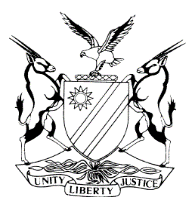PRACTICE DIRECTIVE 61
REPUBLIC OF NAMIBIA

IN THE HIGH COURT OF NAMIBIA, MAIN DIVISION, WINDHOEK
REVIEW JUDGMENT
Case Title: The State v Grace Hango
| Case No: CR: 28/2022 |
High Court MD Review No: 391/2022 | Division of Court: Main Division |
Heard before:
Judge Liebenberg et Judge January | Delivered on:
11 April 2022
|
Neutral citation: S v Hango (CR 28/2022) [2022] NAHCMD 182 (11 April 2022)
|
The order:
The conviction and sentence in respect of count one (fraud) is confirmed. The conviction and sentence in respect of count 2 as regards the charge of forgery is confirmed, while the conviction on the charge of uttering is set aside. |
Reasons for order: |
Liebenberg, J ( concurring January, J) This review came before me in terms of section 302 (1) and section 303 of the Criminal Procedure Act 51 of 1977 (the CPA).
The accused appeared before the Magistrate’s Court in the district of Swakopmund where she faced a charge of fraud (count 1) and a charge of forgery and uttering (count 2). She pleaded guilty to both counts and the court invoked s 112(1)(b) of the CPA. According to the review cover sheet, the accused was convicted of two counts only, namely fraud and forgery and uttering. She was subsequently sentenced to 36 months’ imprisonment in respect of count 1 and to 12 months’ imprisonment in respect of count 2.
Although the accused pleaded guilty to the two counts, the magistrate entered a third count on the charge sheet. This likely came about because count 2 is formulated in such way that it embodies the offences of forgery and uttering as two separate offences. The latter, however, is not numbered as count 3. This notwithstanding, the magistrate questioned the accused on all the counts and convicted her as charged.
Count 1 and count 2 relates to a Namibia Senior Secondary Certificate which the accused forged and presented to the prejudice of the Ministry of Education and thereby defrauded the said Ministry of N$ 53 846,99 in salary payments. A query was directed to the magistrate as to whether the convictions on both counts do not constitute a duplication of convictions. The magistrate in her response correctly conceded that the convictions on both counts amounted to a duplication of convictions and requested the conviction and sentence on count 2 to be set aside.
In S v Gaseb, O'Linn AJA at p 150 E-I approved of Hannah J's judgment in S v Seibeb and S v Eixab, where the learned judge stated as follows: 'There is no single test. This is so because there are a large variety of offences and each has its own peculiar set of facts which might give rise to borderline cases and therefore to difficulties. The tests which have been developed are mere practical guidelines in the nature of questions which may be asked by the Court in order to establish whether duplication has occurred or not. These questions are not necessarily decisive (S v Grobler en 'n Ander (supra); R v Kuzwayo 1960 (1) SA 340 (A)).
The most commonly used tests are the single intent test and the same evidence test. Where a person commits two acts of which each, standing alone, would be criminal, but does so with a single intent, then he ought only to be indicted for, or convicted of, one offence because the two acts constitute one criminal transaction. See R v Sabuyi 1905 TS 170 at 171. This is the single intent test. If the evidence requisite to prove one criminal act necessarily involves proof of another criminal act, both acts are to be considered as one transaction for the purpose of a criminal transaction. But if the evidence necessary to prove one criminal act is complete without the other criminal act being brought into the matter, the two acts are separate criminal offences. See Landsdown and Campbell South African Criminal Law and Procedure vol V at 229, 230 and the cases cited. This is the same evidence test.’
It is evident that in this instance the evidence necessary to establish uttering the forged Senior Secondary Certificate, was the same evidence required to prove fraud, i.e. that the accused knowingly submitted the forged document with the intention to defraud the Ministry of Education. Under these circumstances a conviction of the more serious offence (fraud) should follow and the conviction and sentence of uttering should be set aside.
In the result the following order is made: The conviction and sentence in respect of count one (fraud) is confirmed. The conviction and sentence in respect of count 2 as regards the charge of forgery is confirmed, while the conviction on the charge of uttering is set aside.
|
|
|
J C LIEBENBERG JUDGE | H JANUARY JUDGE |
